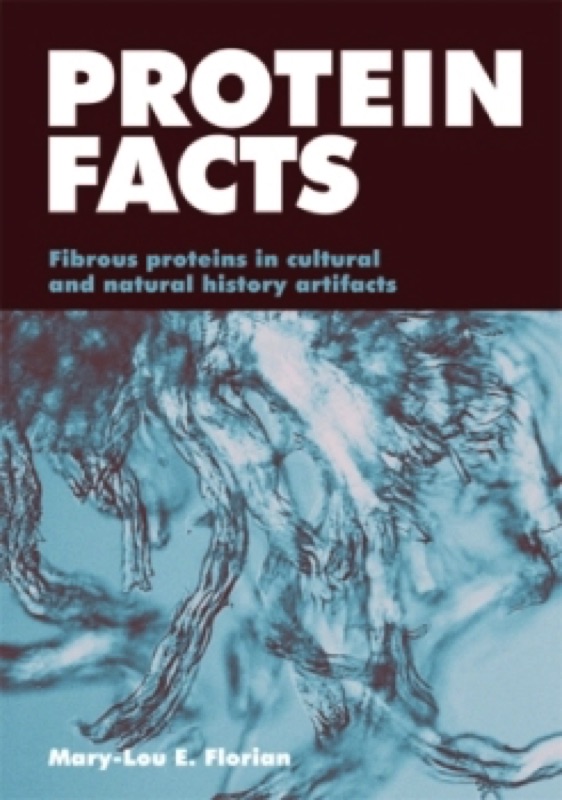This book is designed to help collections managers, conservators, curators, collectors and students (of materials and material culture) to understand the properties of the materials (containing protein fibres) from which various objects have been manufactured.
The author illustrates the wide range of historic, ethnographic and natural history objects, made of fibrous protein material, which is found in collections. She explains why understanding the chemical and phsyical structure of the fibrous proteins in a variety of materials (skin, leather, gut, muscle, teeth, bone, ivory, silk, fur, feathers, hair, horn, claws, nails, etc) is most important when considering optimum methods for their care, conservation treatment and preservation.
Features of the structures of protein fibres uses to identify each material are discussed. The agents and symptoms of deterioration of fibrous proteins are covered, particularly those proteins (e.g. collagen, keratin, fibroin and myosin) found commonly in collections of cultural objects.
This volume complements the author's Fungal Facts published by Archetype Publications in 2002.
Preface
Acknowledgements
Introduction
The manual
Why group heritage artifacts and natural history specimens together?
Why is it important to study the basic information on the cellular tissue structure and the protein chemistry of these materials?
Hierarchy of structure of the fibrous protein material
Basic structure of the different fibrous proteins in the materials
The structural strength and other physical-chemical characteristics of proteinaceous materials
The colloidal nature of the proteins
An interdisciplinary approach
The structure of the skin and its derivatives, and other collagenous tissues used in heritage objects
The skin of vertebrates
Introduction
Epidermis
Dermis
Colours in the skin
Fish skins
General structure
Epidermis
Dermis
Reptile skins
Introduction
Snakes and lizards
Crocodiles and alligators
Turtles
Birds
Structures of epidermal skin and extensions (scales, claws, beaks and feathers)
Structural colours
Mammalian skins and structures of epidermal origin
Hair structure, species identification, colour, moulting, modified hairs and deterioration
Horn
Claws, nails and hooves
Skin of marine mammals
Gut, ligament and tendons
Biologically mineralized tissue: mammalian teeth and bones
Enamel and dentin structures: teeth and ivory
Bony structures: bones and antlers
Amino acids: the building blocks of fibrous proteins
General structure of fibrous proteins
Amino acids
What is the role of amino acids?
General characteristics of amino acids
Amino acid reactions and changes
Agents of protein deterioration
Introduction
Water and hydrolysis
Water as a liquid and vapour
Some reactions involving water
Oxygen, light and lipids
Oxygen
Free radicals, light and lipids
Air pollution gases: ozone, sulphur dioxide, nitrogen dioxide and carbon dioxide
Ozone
Sulphur dioxide
Nitrogen dioxide
Carbon dioxide
Metals and salts
Heat
Water in fibrous protein materials
Introduction
The nature of water
The states of water and energy of change
Vapour pressure and the activity of water
Water vapour in the air
Relative humidity (RH), absolute humidity (AH) and temperature
The importance of the dew point and microenvironments
The characteristics of water in fibrous and colloidal materials
Location and properties of water in the protein materials
Release of water from drying materials
Equilibrium moisture content (EMC) and regain ability of materials
Hysterical hysteresis
Chemicals in materials: changes in water activity (a(W)) in materials
Colloids
What are colloids?
Gelatin and the importance of the glass transition point
The role of water and biodeterioration
Collagen structure
Introduction
Molecular organization
Polypeptide chain: the protein molecule
Three-chained molecule: tropocollagen
Water in the collagenous material: inside and outside
Tanning: processes, deterioration and interaction with collagen
Introduction
Pre-tanning processes
Tanning processes
Smoking
Oil process and chamois tannage
Alum tawing
Vegetable tanning
Chrome tanning
Chewing
Finishing processes
Parchment
Deterioration of collagen
Bonds in collagen: sites of deterioration
Chemical changes in deterioration in dry collagen and leather
Chemical deterioration of collagen polymer into peptides
Amino acid changes in deteriorated leather
Physical changes due to hydration of collagen in wet skins, leather and natural history specimens
The water in wet skins
Swelling of collagen
Influence of salts and others deteriorating agents on hydrated collagen
Acid and alkaline conditions: pH
Neutral salts
Non-electrolytes
Radiation
Biodeterioration
Denaturation and shrinkage temperature of hydrated collagen
Denaturation
Shrinkage temperature
Shrinkage temperature as a method of assessment of the deterioration state of collagenous materials
Collagen changes in natural history specimens due to preservation methods
Effects of alcohols on hydrated collagen in liquid storage of natural history specimens
Effects of aldehydes on hydrated collagen in liquid storage of natural history specimens
Reported interactions of many natural history preparation methods on collagen
Keratin
Molecular organization: coiled coils
Cellular organization: keratinization of tissue
Keratin as a colloid
Chemical reactivity of keratin
Introduction
Chemical deterioration
Biodeterioration
Silk
Source
Structure of fibroin
Reactivity of fibroin
Deterioration by metals used in weighting silk
Analysis of deterioration of fibroin polymer
Striated muscle and elastin in fluid-preserved natural history specimens
The fluids and their chemicals
Striated muscle proteins
Muscle tissue and function
Myosin and actin
Elastin
Post-mortem changes
Bibliography
Index
